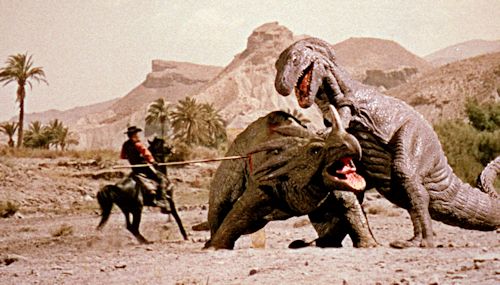 |

No. 39 -
The Valley of Gwangi (1969)
Charles H. Schneer Productions,
Warner Bros.-Seven Arts
Cowboys Battle Monsters in the
Lost World of Forbidden Valley!
|
 |
The Valley of Gwangi (1975),
DML Rating:
★★★★★★★★★☆
- near perfect
Director: Jim O'Connolly;
Screenplay: William Bast, Julian More,
Willis O'Brian;
Rated Approved
Starring: James
Franciscus, Gila Golan, Richard Carlson, Laurence Naismith, Freda
Jackson, Gustavo Rojo, Dennis Kilbane, Curtis Arden
Movie Introduction: In old Mexico at the turn of the
century, a wild west show is looking for new ideas. The beautiful
T. J. Breckenridge (Golan) has found a new attraction, a living miniature
horse (a prehistoric Eiohippus), whose origin is a hidden place called the Forbidden Valley.
Tia, a
gypsy woman demands that the horse be returned, but the West Show
refuses. Later that evening, the gypsy's servant frees the animal,
and it heads for the distant Valley. Along with her
former boyfriend Tuck Kirby (Franciscus), and a British paleontologist
Sir Horace Bromley (Naismith), T.J. and the show's wranglers venture out
to recapture the
dawn horse.
It leads them into the Forbidden Valley. There, to their astonishment,
they encounter
oversized lizards - dare we say,
living dinosaurs! The cowboys barely escape with their boots, as a
sharp-toothed Allosaurus crashes through the hidden entrance knocking
himself unconscious. The gypsy calls him Gwangi, the evil one. They
believe that taking Gwangi from the Valley will bring a curse upon all
those involved. The cowboys ignore this advice and decide that Gwangi is
the new main attraction they have been looking for. What could go wrong,
right?
 Defining Moment:
Gwangi's valley Defining Moment:
Gwangi's valley
After clearing the hidden cave entrance
to be large enough for horses, the cowboys slide through and enter the Forbidden
Valley in search of the missing Eiohippus. Suddenly an 6-foot Ornithomimus
appears, and the riders give chase. As the creature almost escapes, a
much larger Allosaurus
springs onto the screen and clamps its gigantic jaws down on the smaller dinosaur,
crushing and devouring it.
This stops the startled riders dead in their tracks. This amends their
plan to "Let's get the hell out of here!"
NOTE: Steven Spielberg paid homage to
this scene in
Jurassic Park
(1993), when the T-rex bursts on the screen
and chomps on one of the fleeing Gallimimus.
Something subtle you might have missed: jurassic
chameleon
One negative thing critics always point
out is that our titular dinosaur baddie changes color throughout the film.
And well, he does. At one point he's blue. Then he's muted gray. Finally
he's kinda greenish. Perhaps you would not have noticed it hadn't
I said anything. I frankly don't care. I never noticed it until I read it
in a review. So my best advice, just ignore it. Maybe someday, using the
wonders of technology, they will fix that little imperfection.
Memorable Quotes:
"This circle of mountains,
jagged peaks, steep cliffs, could be the perfect barrier against man and
the elements." - Professor Bromley
"He who takes from Gwangi
the evil one is cursed." – Tia Zorina, the gypsy woman
 Dad's Review: Dad's Review:
Years before Crichton and
Spielberg gave us
Jurassic Park
(1993), the great Ray Harryhausen (from
a story by Willis O'Brien) put together this wonderful fantasy where
dinosaurs and men are thrown together in the Old West of Mexico in 1885.
In my ten-year-old mind, this
film was my holy grail. I loved Westerns. I loved dinosaur films, and I watched all
that I could (see the list below). THIS WAS BOTH! We lived in El Paso at the time, and my friend Mike and I would
pretend we were on horse back and "ride" through the desert behind my
house. We were cowboys in the Forbidden Valley. Gwangi would chase us,
and we'd barely escape with our lives... that was so much fun!
The creatures here were created using stop-motion animation.
A simple explanation of the process is that you take a picture of the
subject, which is a miniature model made of flexible plastic or clay.
Then you move the model slightly and take another picture. When you play
the pictures in succession, at a faster speed, the model appears to
move, to come to life. Ray Harryhausen was the master of this technique.
I realize that
by today's CGI
standards the creature movements seem a bit choppy. However, I still
think it is amazing to watch. Just think of the mastery and patience it
would take to create those scenes! To this day, when the cowboys rope
Gwangi, I am in awe. It is a near perfect combination of stop motion and
live actors - it stands up today against any CGI out there! That's my
story and I'm sticking to it!
Another favorite scene is Gwangi's
escape and battle with the circus elephant. (see the full scene on
YouTube)
I can't mention this film with
recognizing the Mexican boy,
Lupe. He's about ten years old. His presence in the film is priceless. He
is the only one who sees Gwangi as the creature he is, not a monster or some prize to be
captured and displayed. At the film's end, when Gwangi meets his fiery fate,
Lupe cries.
So do I.
Every. Time.
For for your film enjoyment... Top early Dinosaur films, excluding, Gwangi.
Onto No. 40... The Unlucky Combatant
|



